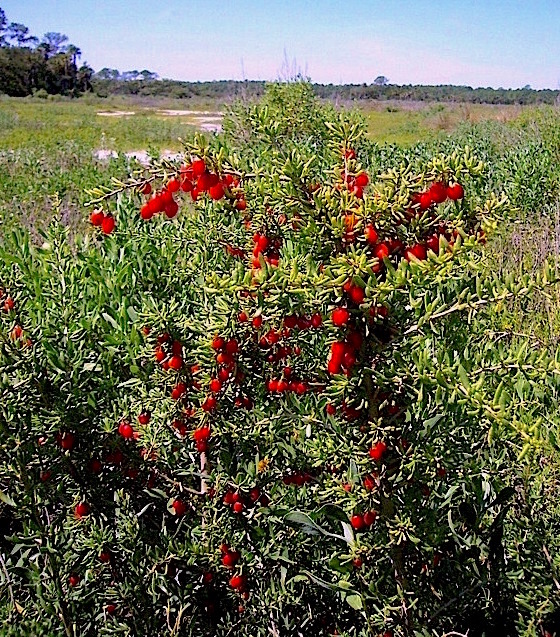
Looking like skinny red jelly beans, Goji fruit is in the greater nightshade family so those with allergies beware. Photo by Green Deane

Goji are blossoming for winter harvesting. Photo by Green Deane.
Wrong turns can lead to discovery, in this case dozen of goji berry shrubs. The foraging class was at Ft. Desoto last weekend. A blocked path and mosquito distractions led to a wrong turn which revealed a patch of Goji berries in blossom. That means fruit around Christmas into late spring. Finding goji berries at Ft. Desoto was not unusual as there are plants scattered among the islands. Gojis like brackish water. Another place to find them, other side of the state, is the low-tide west side of Turtle Mound near Daytona Beach — follow the path — and in Spruce Creek Park, and the adjacent Doris Leper Park. In Leper Park follow the old U.S. Route 1 road south. Gojis are high in iron and vitamin A, with some fiber, vitamin C and zeaxanthin, an antioxidant. Research shows daily goji berry consumption can help protect against macular degeneration. To read more about Goji berries go here. Video here
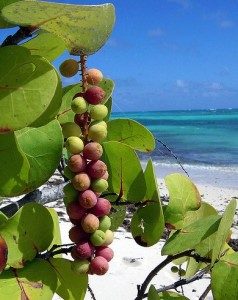
V Seea Gapes thrive in beach-like conditions.
Sea grapes, Coccoloba uvifera are starting to ripen. Instead of ripe bunches there is an occasional ripe fruit, a delightful hint to the crop to come. Sea Grapes, in the buckwheat family, are a protected species, not because they are rare but they help maintain sea side sand dunes, as do protected Sea Oats now full of grain, too. Sea Grapes have a unique sweet flavor which disappears when made into jelly. They are best eaten right off the tree. However, sea grape wine is a delightful native homemade beverage, common a couple of generations ago. Don’t confuse asian reports of sea grapes. Those can refer to an algae, Caulerpa lentillifera, also called sea grapes. Only female Sea Grape trees produce fruit, if there is no male tree around female trees won’t fruit.They also need bees. Sea Grape leaves can be used to make a tea. To read more about sea grapes go here. Video here.
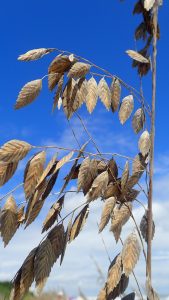
Sea Oats. Photo by Green Deane
The grain pictured right, Uniola paniculata, is edible though it does not produce a lot of seed. It is also protected. It’s not protected because it is rare. In fact it’s very common. But the plant’s roots helps keep Florida’s coastal dunes in place thus Sea Oats are protected. I have known some folks to grow Sea Oats in their backyard as a long-lived perennial grass. They are very drought tolerant and highly regarded by browsing animals such as deer but are lowly regarded by grazing animals such as cows. As Sea Oats are protected you might want to find a similar looking relative in the forests of Florida. They are called… Wood Oats… not too imaginative. Wood Oats are edible as well and not protected. Use them as you would cultivated oats. They are easy to identify: They look like Sea Oats just in the wrong place. To read about Sea Oats click here.
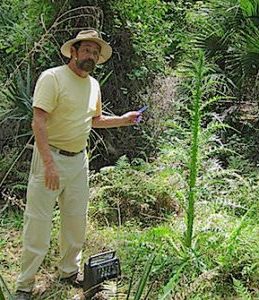
Foraging classes are held rain, shine, hot or cold. Photo by Nermina Krenata
Foraging Classes:
Saturday September 14th, Mead Garden:1500 S. Denning Dr., Winter Park, FL 32789. Meet at the bathrooms. 9 a.m. to noon.
Sunday September 15th, Bayshore Live Oak Park, Bayshore Drive. Port Charlotte 9 a.m. to noon, meet at the parking lot at Bayshore Drive and Ganyard Street.
Saturday September 21, Spruce Creek Park, 6250 Ridgewood Ave. Port Orange, 32127. 9 a.m. to noon. Meet at the pavilion.
Sunday September 22nd, Eagle Park Lake,1800 Keene Road, Largo, FL 33771. 9 a.m. to noon, Meet at the pavilion near the dog park,
For more information on these classes, to prepay or sign up go here. The cost is $30 per adult (the class is usually three hours long and examines five-dozen or so species.) If cost is a hardship email me at: GreenDeane@gmail.com.

Green Deane Forum
Tired of Facebook and want to identify a plant? The Green Dean Forum is up and running again. Have you come to dislike Facebook, then join us on the forum. Perhaps you’re looking for a foraging reference? You might have a UFO, an Unidentified Flowering Object, you want identified. On the Green Deane Forum we — including Green Deane and others from around the world — chat about foraging all year. And it’s not just about warm-weather plants or just North American flora. Many nations share common weeds so there’s a lot to talk. There’s also more than weeds. The reference section has information for foraging around the world. There are also articles on food preservation, and forgotten skills from

You get the USB, not the key.
172-video USB would be a good end of spring present and is now $99. My nine-DVD set of 135 videos has been phased out. The USB videos are the same videos I have on You Tube. Some people like to have their own copy. Most of the 172 USB videos have to be copied to your computer to play. If you want to order the USB go to the DVD/USB order button on the top right of this page. That will take you to an order form.

Now in second printing.
EAT THE WEEDS, the book, 274 plants, 367 pages, index, nutrition charts and color photos. It’s available in many locations including Amazon. Most of the entries include a nutritional profile. It can also be ordered through AdventureKeen Publishing.
This is weekly newsletter #611. If you want to subscribe to this free newsletter you can find the sign-up form in the menu at the top of the page.
To donate to the Green Deane Newsletter click here.
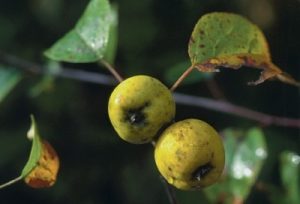
Wild Apples can be bitter.
Apple season is upon us, depending where you live. When I was a kid back in the BC era — Before Computers — I always associated going back to school with raiding apple trees. (We always went back to school on the Tuesday after Labor Day.) I also raided the concord grapes in the nearby hedg`e rows as well. The actual word for that is “scrumping” (which was a verb for juvenile fruit stealing long before modern slang added naughty meanings. The internet is a sewer capable of flowing into every home.) There were orchard apples trees and there were wild apple trees. Sometimes the wild apples were from cultivated apples that grew up literally from a tossed apple core. Other times they were real wild apples, small and tart if not bitter. Those were usually better off cooked by a camp fire along a river while fishing after school. I walked or biked four miles to school daily and often didn’t get home until after dark (which means I thankfully missed anything my mother tried to cook.) Where I grew up there were many abandoned homesteads with flourishing apple trees in unused yards. There is something philosophical knowing the cared-for apple tree outlived family and home. Back then there was also a greater variety of apples than even just a few decades later because of mechanization. Even when I was young there was a great diversity of apples. Some would not store at all — eating apples — some that would stay hard for months only softening in mid-winter or spring. Others were only good for cider or cooking and or just jelly. And contrary to common belief, apples will grow in Florida. I recommend Apple Anna, a very nice blush apple. I never got Ein Shemer apple to fruit in Central Florida.To read more about apples go here.
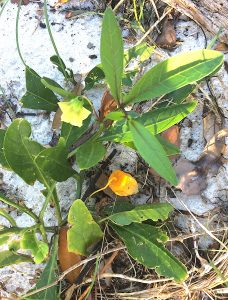
As the Ground Cherry ripens the husk turns golden. Photo by Green Deane
Our timing Saturday was off. The husks of the Coastal Ground Cherry were green to a tan, dry, and papery. Ground cherries, in this case Physalis angustifolia, ripen from green to gold, getting sweeter and tangier as they go along. But they can often have a bitter after taste either from being under ripe or some species just retain some bitterness. A little aftertaste of bitterness is okay but the best is when there is none. Thus one always tastes a ripe ground cherry then waits a minute or so for any bitterness to appear.
While local Ground Cherries can fruit nearly all year, they do produce a spring and fall crop. In cooler climes they just have one season ripening in late summer and fall. Here our fall crop tends to be better than our spring one. Spring ground cherries can rot on the plant or get damaged by insects and that is also when I tend to find more bitter ones. But this time of year brings out the best in ground cherries. One can find whole, undamaged, very ripe Ground Cherries in significant numbers. You can make a pie out of them if you can manage to get some home uneaten. Incidentally there is a second local ground cherry that resembles the Coastal Ground Cherry. It’s Physalis walteri, also known as starry-hair ground-cherry and sand cherry. It has star-shaped hairs on the lower edges of the leaf which are visible with a hand lens. Still edible, however. To read more about Ground Cherries go here.

